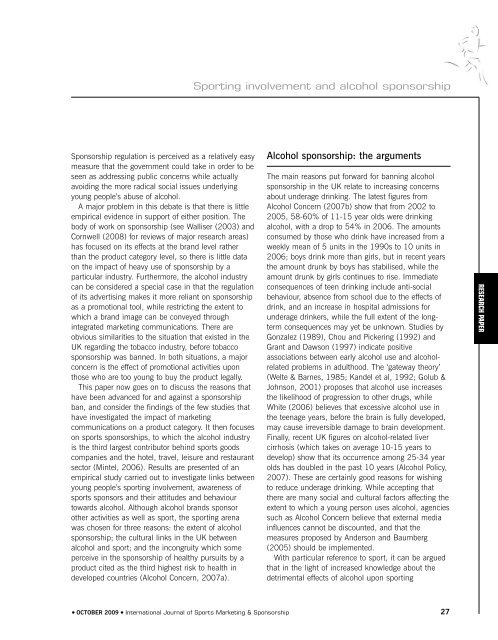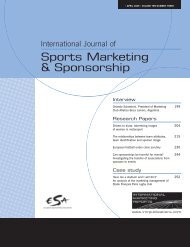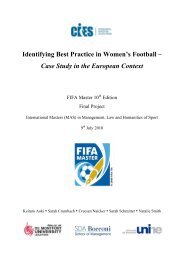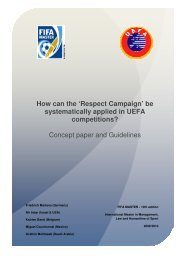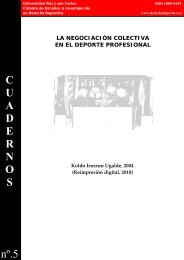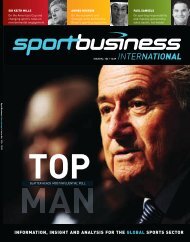Sports Marketing & Sponsorship - FIFA/CIES International University ...
Sports Marketing & Sponsorship - FIFA/CIES International University ...
Sports Marketing & Sponsorship - FIFA/CIES International University ...
- No tags were found...
You also want an ePaper? Increase the reach of your titles
YUMPU automatically turns print PDFs into web optimized ePapers that Google loves.
Sporting involvement and alcohol sponsorship<strong>Sponsorship</strong> regulation is perceived as a relatively easymeasure that the government could take in order to beseen as addressing public concerns while actuallyavoiding the more radical social issues underlyingyoung people’s abuse of alcohol.A major problem in this debate is that there is littleempirical evidence in support of either position. Thebody of work on sponsorship (see Walliser (2003) andCornwell (2008) for reviews of major research areas)has focused on its effects at the brand level ratherthan the product category level, so there is little dataon the impact of heavy use of sponsorship by aparticular industry. Furthermore, the alcohol industrycan be considered a special case in that the regulationof its advertising makes it more reliant on sponsorshipas a promotional tool, while restricting the extent towhich a brand image can be conveyed throughintegrated marketing communications. There areobvious similarities to the situation that existed in theUK regarding the tobacco industry, before tobaccosponsorship was banned. In both situations, a majorconcern is the effect of promotional activities uponthose who are too young to buy the product legally.This paper now goes on to discuss the reasons thathave been advanced for and against a sponsorshipban, and consider the findings of the few studies thathave investigated the impact of marketingcommunications on a product category. It then focuseson sports sponsorships, to which the alcohol industryis the third largest contributor behind sports goodscompanies and the hotel, travel, leisure and restaurantsector (Mintel, 2006). Results are presented of anempirical study carried out to investigate links betweenyoung people’s sporting involvement, awareness ofsports sponsors and their attitudes and behaviourtowards alcohol. Although alcohol brands sponsorother activities as well as sport, the sporting arenawas chosen for three reasons: the extent of alcoholsponsorship; the cultural links in the UK betweenalcohol and sport; and the incongruity which someperceive in the sponsorship of healthy pursuits by aproduct cited as the third highest risk to health indeveloped countries (Alcohol Concern, 2007a).Alcohol sponsorship: the argumentsThe main reasons put forward for banning alcoholsponsorship in the UK relate to increasing concernsabout underage drinking. The latest figures fromAlcohol Concern (2007b) show that from 2002 to2005, 58-60% of 11-15 year olds were drinkingalcohol, with a drop to 54% in 2006. The amountsconsumed by those who drink have increased from aweekly mean of 5 units in the 1990s to 10 units in2006; boys drink more than girls, but in recent yearsthe amount drunk by boys has stabilised, while theamount drunk by girls continues to rise. Immediateconsequences of teen drinking include anti-socialbehaviour, absence from school due to the effects ofdrink, and an increase in hospital admissions forunderage drinkers, while the full extent of the longtermconsequences may yet be unknown. Studies byGonzalez (1989), Chou and Pickering (1992) andGrant and Dawson (1997) indicate positiveassociations between early alcohol use and alcoholrelatedproblems in adulthood. The ‘gateway theory’(Welte & Barnes, 1985; Kandel et al, 1992; Golub &Johnson, 2001) proposes that alcohol use increasesthe likelihood of progression to other drugs, whileWhite (2006) believes that excessive alcohol use inthe teenage years, before the brain is fully developed,may cause irreversible damage to brain development.Finally, recent UK figures on alcohol-related livercirrhosis (which takes on average 10-15 years todevelop) show that its occurrence among 25-34 yearolds has doubled in the past 10 years (Alcohol Policy,2007). These are certainly good reasons for wishingto reduce underage drinking. While accepting thatthere are many social and cultural factors affecting theextent to which a young person uses alcohol, agenciessuch as Alcohol Concern believe that external mediainfluences cannot be discounted, and that themeasures proposed by Anderson and Baumberg(2005) should be implemented.With particular reference to sport, it can be arguedthat in the light of increased knowledge about thedetrimental effects of alcohol upon sportingRESEARCH PAPER● OCTOBER 2009 ● <strong>International</strong> Journal of <strong>Sports</strong> <strong>Marketing</strong> & <strong>Sponsorship</strong>27


